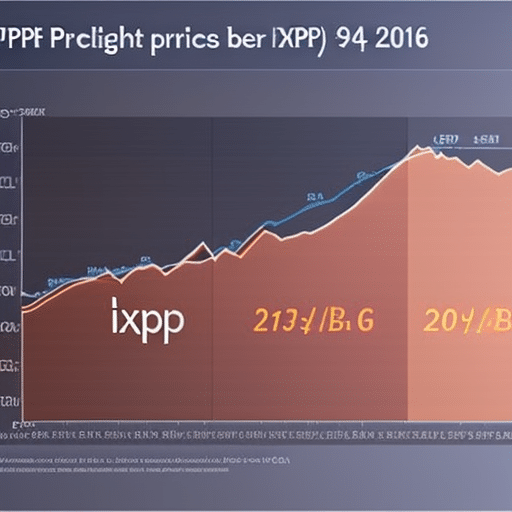Impact Of Partnerships On Xrp Price
Ripple (XRP) is a digital asset, also known as cryptocurrency. As the third largest cryptocurrency in terms of market capitalization, Ripple has seen its price fluctuate significantly over time. In recent years, partnerships between Ripple and various organizations have become an increasingly important influence on XRP’s price. As these partnerships continue to grow, it is important to understand the potential impact they might have on XRP’s performance in order to make informed decisions about investing in the currency. This article will explore how partnerships can affect XRP’s price and what strategies traders can use when trading this asset class. Additionally, it will discuss potential risks associated with investing in XRP and relevant tax implications for investors.
Overview of Ripple (XRP)
Ripple (XRP) is a cryptocurrency and digital payment platform, developed in 2012 as an open-source protocol to enable secure and cost-efficient transactions across the globe. Ripple’s vision is for XRP to become the bridge currency for all payments, providing real-time settlement with end-to-end transparency at low cost. The XRP market capitalization is the third largest amongst all cryptocurrencies, making it one of the most important digital assets currently available. As of 2021, its current market capitalization is over $46 billion. With such a large market cap and high liquidity, investors tend to pay close attention to Ripple’s partnerships and their potential impact on XRP price. Thus, understanding how these partnerships influence the price of XRP becomes essential in order to make informed investment decisions.
Factors influencing XRP price
The volatility of cryptocurrency markets can be likened to a roller coaster ride, making it difficult to accurately predict the value of XRP. Numerous factors can influence XRP’s price, such as its open source technology, which enables developers to build and deploy applications on the blockchain network. Regulatory compliance is another factor that affects XRP’s price since governments across the world are increasingly focusing on regulating cryptocurrencies. Therefore, XRP has had to adjust its technology and policies in order to comply with various regulatory requirements. This has had both positive and negative implications for the price of XRP; while it may attract more investors due to increased confidence in its legitimacy, it could also limit innovation and raise transaction costs associated with meeting legal requirements. Consequently, partnerships have become increasingly important for Ripple (XRP) as they provide an opportunity for greater adoption by banks and other financial institutions.
Benefits of Partnerships
By leveraging strategic collaborations, XRP has the potential to achieve wider adoption and increased usage. Such partnerships can help enhance network scalability, build trust levels in the currency, and drive innovation within the digital asset space. These factors all have a direct impact on the price of XRP, as more people are willing to invest in a cryptocurrency that is deemed reliable and secure.
Partnerships with major entities such as banks or financial institutions can also lead to increased liquidity for XRP, which further boosts its value in comparison to other cryptocurrencies. As more individuals gain access to this asset class due to improved market infrastructure, there is an expectation that XRP will experience steady growth over time. Consequently, these collaborations have an immense effect on the overall price performance of XRP; therefore it is essential for investors to consider them when making decisions about their investments. With this knowledge, one can make informed decisions that could potentially result in higher returns from their investment in XRP.
Impact of Partnerships on XRP Price
Through strategic alliances, the value of the digital asset can be influenced due to increased trust, scalability, and innovation. Ripple’s partnerships provide a unique opportunity for XRP to reach its full potential as a cryptocurrency. These strategic partnerships also have a direct impact on XRP’s price because they bring more exposure and attention from investors. As more and more companies enter into agreements with Ripple, potential investors are likely to feel secure in investing in XRP because of the level of trust that is associated with these partnerships. Furthermore, by leveraging blockchain technology Ripple has been able to expand its network which increases the utility uses of XRP and makes it more attractive to investors who may not have considered investing before. The integration of Ripple’s technology into existing financial institutions has enabled faster transactions and improved liquidity for users worldwide, further increasing the appeal of investing in XRP. Therefore, by forming strategic partnerships with leading organizations across various industries, Ripple has been able to increase investor confidence in their asset which has had an overall positive impact on the price of XRP. This trend is expected to continue as Ripple continues to form new alliances around the globe in order to expand its user base and become even more competitively advantageous in terms of cost-effectiveness compared with other digital assets available today. As such, it is clear that partnerships play an integral role when it comes to influencing the price movements of XRP.
Ripple’s Recent Partnerships
Recent partnerships between Ripple and leading organizations across multiple industries have presented a unique opportunity for the digital asset to reach its full potential. These investment opportunities have sparked heightened interest in XRP, which has been reflected in the increased market capitalization of the currency. This trend suggests that Ripple’s partnerships are likely to continue driving up prices as more entities discover the immense potential of XRP. Additionally, these partnerships also provide insight into emerging partnership trends, allowing investors to better assess the long-term price of XRP based on their knowledge of industry developments. As such, Ripple’s recent partnerships have provided both short-term gains and longer-term insights into the future of XRP that will be beneficial for stakeholders in the coming years. Consequently, it is clear that Ripple’s recent partnerships have had a positive impact on market capitalization and will likely continue to do so going forward.
Impact on Market Capitalization
The influx of investments resulting from Ripple’s strategic partnerships with big banks, financial institutions and payment services have significantly bolstered its market capitalization. In addition to providing a much-needed boost in terms of finances, these alliances also lend credibility to the digital currency, as it signals the compliance of Ripple with existing regulations regime. The following are some key points that indicate how such partnerships can greatly influence XRP market capitalization:
- Increased liquidity: As more partners join Ripple’s network, the total number of users trading XRP increases exponentially which helps facilitate quick trades and ensure better price stability.
- More investors confidence: With increased adoption among financial institutions, individual investors are likely to be more confident about their investment in XRP as well as other cryptocurrencies.
- Lower risk factor: By adhering to regulatory guidelines and establishing good relationships with government bodies across the globe, Ripple is able to reduce any potential risks associated with investing in virtual currencies like XRP or other altcoins.
- Higher demand for coins: This heightened trust in Ripple’s technology will eventually lead to an increase in demand for XRP coins which can result in a rise in price due to basic economic principles of supply and demand.
Overall, it is evident that forming strong partnerships has been beneficial for both Ripple and its native cryptocurrency XRP since it has allowed them to gain greater visibility on the global stage while simultaneously boosting market capitalization substantially by inspiring investor confidence and reducing risk factors associated with buying into this volatile asset class.
Increased Liquidity
The market capitalization of a cryptocurrency, such as XRP, is an important factor in determining the value of the token. A higher market capitalization increases investor confidence and can lead to increased liquidity for XRP tokens. Increased liquidity leads to more frequent trades being made and a greater volume of transactions taking place. High frequency trading and the creation of liquidity pools are two ways that partners of Ripple have been able to increase the overall liquidity for XRP tokens, thus improving its market capitalization.
This increased liquidity has had a positive impact on the price stability of XRP tokens due to improved market depth. With more buyers and sellers participating in trades, it becomes easier for traders to enter and exit positions in order to take advantage of short-term opportunities or hedge against risk. As such, with improved liquidity comes less volatile prices which make it easier for investors to plan their strategy over a longer period without having to worry about sudden changes in prices. This makes XRP an attractive investment option for many investors looking for long-term gains from their investments. The next section will explore how partnerships have impacted the price volatility of XRP tokens.
Price Volatility
Price volatility of XRP is a key factor to consider when evaluating its performance. Short-term spikes have been observed, although the long-term trend has generally been relatively stable. By understanding the factors that drive both short and long-term volatility, investors can make more informed decisions when considering investments in XRP.
Short-term spikes
Recent reports indicate that short-term spikes in XRP’s price can be attributed to successful partnerships. These partnerships cause an increase in demand for the cryptocurrency, temporarily resulting in a higher price. However, it is difficult to determine the projected effects of such a partnership on long-term stability due to regulatory controls and other factors which may influence the market. As such, it is important to consider how these short-term spikes affect long-term stability when assessing potential investments into XRP.
Long-term stability
Analyzing long-term stability of a cryptocurrency requires exploring numerous elements, from regulatory controls to potential market influences; like piecing together a puzzle, the picture is clearer when all the pieces are in place. The impact of partnerships on XRP price can be seen through its global reach and investor confidence. Global reach allows for XRP to be available across multiple exchanges, creating more liquidity for investors and increasing demand. Additionally, partnerships with financial institutions help to increase investor confidence as they provide more trust in the currency’s value. This helps drive up the price of XRP over time due to increased demand and trading activity.
| Element | Impact on Price |
|---|---|
| Global Reach | Increased Demand & Liquidity |
| Investor Confidence | Increased Demand & Trading Activity |
Exchange Rates
Examining the impacts of exchange rates on XRP price is a key factor in understanding the potential effects of partnerships on the cryptocurrency. Exchange fees, which are determined by currency hedging, directly affect the price of XRP and its ability to be exchanged for other digital assets. These fees can add up quickly if partners are exchanging multiple times per month, leading to an increased risk of loss. Additionally, fluctuations in exchange rates may also have a negative impact on XRP prices as it could lead to losses due to unanticipated volatility. This means any partnership that involves frequent exchanges should take into consideration potential risks associated with exchange rate changes. To mitigate these risks, organizations should engage in currency hedging strategies or use methods such as forward contracts and options to protect against unfavorable shifts in exchange rates. Improved security measures also play an important role in reducing the impact of partnerships on XRP prices and ensuring long-term stability.
Improved Security
Strengthening security protocols is essential for mitigating the risks associated with frequent currency exchanges. Specifically, Ripple has made efforts to improve security by providing:
- Lower fees: By leveraging their partnerships and expanding their network, Ripple is able to reduce the fees associated with sending cross-border payments. This makes it easier for customers to access more competitive rates and make international transactions without worrying about costly fees.
- Improved speed: Ripple’s adoption of distributed ledgers allows for faster transaction times compared to traditional banking systems. This improved speed can help optimize customer experience and lead to increased trust in the system as a whole.
These improvements are important for increasing consumer confidence in XRP transactions and helping drive its price up in the long run. However, there are still potential risks that come with relying heavily on partnerships, which should be taken into consideration when evaluating its impact on XRP prices.
Potential Risks
Despite the benefits of improved security, there are potential risks that should be considered when evaluating Ripple’s impact on cross-border payments. One such risk is that an increased rate of adoption for Ripple could negatively affect the economic implications associated with its XRP token. In particular, if demand for XRP increases faster than its supply, then the price could increase beyond a market equilibrium level and become volatile or even crash. Similarly, if demand decreases too quickly or unexpectedly, the price could plummet considerably. Therefore, it is important to consider these potential risks when predicting how partnerships will influence XRP prices in the long run. To mitigate potential losses due to uncertain market conditions, traders must develop appropriate strategies for trading XRP accordingly.
Strategies for Trading XRP
To navigate the potential risks associated with Ripple’s XRP token, traders must develop effective strategies for trading cryptographically. Technical analysis and fundamental analysis are two common methods of analyzing market data and finding optimal entry and exit points when trading cryptocurrency. Traders who use technical analysis typically use charting software to identify trends in the price action of an asset. Fundamental analysis involves researching news and other events that may affect the value of a digital currency or blockchain-based project. By combining both methods, traders can formulate a comprehensive strategy for investing in XRP tokens while mitigating the risk associated with volatile markets. With a well-crafted investment approach, traders can capitalize on opportunities presented by Ripple’s partnerships and other external factors that drive price movements. Without careful consideration of the underlying fundamentals, however, investors could suffer losses due to fluctuations in prices caused by partnership announcements or other unexpected events. A well-balanced approach to trading XRP is thus essential for achieving success in this dynamic market environment.
Investing in XRP
| Investors must consider a range of factors when evaluating the potential return on investing in Ripple’s XRP token. It is important to understand the technology behind Ripple and XRP, as well as how it is being used and its potential for growth. | Factors | Description |
|---|---|---|
| Ripple Technology | Ripple is an open source payment system that utilizes blockchain technology to facilitate fast and secure transactions. | |
| XRP Mining | XRP can be mined using computer hardware, although it may take longer than Bitcoin or other cryptocurrency mining processes due to its unique algorithm. |
When investing in XRP, investors should also consider the tax implications associated with their holdings. Tax laws vary greatly by country and jurisdiction, so investors should consult a tax advisor familiar with cryptocurrency investments before making any decisions about their investments. The transition from this section into the next one will focus on the taxation of cryptocurrencies around the world in order to help readers better understand their tax liabilities when investing in XRP or any other cryptocurrency.
Tax Implications
Taxation of cryptocurrencies is a complex issue that requires careful consideration when investing in XRP or any other cryptocurrency. The adoption rates of digital currencies, such as XRP, have increased significantly over the recent years. As a result, governments are beginning to adjust their regulations in order to accommodate for this new asset class. The implications of these regulation changes on taxation has wide-ranging consequences for investors and traders of XRP. For example, nations like the United States require taxes to be paid on profits from trading cryptocurrencies such as XRP and other digital assets. This means investors have to account for capital gains tax when disposing their holdings. Furthermore, countries may also impose sales taxes on purchases with cryptocurrency like XRP which further complicate the taxation of investments made with it. Investors need to be aware of these changes and consult with a professional tax advisor before making an investment decision.
Frequently Asked Questions
What type of partnerships does Ripple have?
Like an intricate web, Ripple has established partnerships with a variety of protocols and liquidity providers. By connecting different networks and exchanges, Ripple is able to facilitate global payments at a lower cost and faster speed. Analytically, these collaborations have enabled Ripple to expand its reach and increase the accessibility of its services.
What are the differences between trading XRP and investing in XRP?
When trading XRP, investors need to consider buying strategies and price predictions as part of their investment decision. Investing in XRP requires a different approach, where an investor must assess the potential returns versus the associated risks.
How does Ripple ensure the security of its partners?
Expertly ensuring financial stability and regulatory compliance, Ripple proactively partners with leading institutions to protect its partners through rigorous data-driven analysis. Utilizing advanced techniques, Ripple vigilantly verifies and monitors all partnerships for optimal security.
What are the possible risks associated with investing in XRP?
Investing in XRP carries risks of volatility and liquidity risk, as the price can be subject to sudden swings, or lack of buyers/sellers. Such uncertainties may impact the value of investments in XRP over time.
What are the tax implications of trading and investing in XRP?
The legal ramifications and tax exemptions of trading and investing in XRP vary depending on the country. Investors should research their local laws to determine what taxes they may be liable for when trading XRP. An analytical, data-driven approach is recommended when assessing the potential risks associated with investing in XRP.



